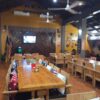
BC Cook
AROUND Saipan you see many names and places related to sugar: Sugar Dock, Sugar King Road, Sugar KingPark, the old sugar train. Clearly, this was an important part of the island’s history. Many visitors to Saipan ask me why there is no sugar industry on the island today even though it was such an important part of the economy in the past. Let’s look at the sugar era on Saipan and the man known as the Sugar King.
It all started when the Japanese took control of the Marianas after the First World War. Looking for a way to make the islands profitable, Japanese businessmen realized that the climate and soil were perfect for growing sugar, then in high demand on world markets. Haruji Matsue, the Sugar King, surveyed the island and chose the best areas to bring under cultivation. He decided not to hire islanders but brought in workers from Japan and Okinawa to work the sugar fields. Matsue also needed a way to move the harvested sugar from the fields to the warehouse and docks, located in Chalan Kanoa, so he built a railroad network connecting the various parts of his growing sugar empire.
By the mid 1920s the sugar industry on Saipan boomed. Thousands of workers tilled, cultivated, and harvested. They transported the crop to the CK sugar dock where it was loaded onto ships and sent to foreign markets, mainly in Japan. Even Tinian and Rota were brought under cultivation. Matsue made a fortune. Then disaster struck. When war erupted in the Pacific in 1941 the Japanese had other priorities. Even though sugar was still in demand the demands of war took precedence. Saipan became a major military base and the sugar industry was forgotten. During the battle for the island in 1944 nearly all CK, including the sugar warehouse and other facilities, were destroyed. The railroad lines and equipment were also heavily damaged.
After the war the sugar industry did not return to the island. There were many reasons for this. One, the islands now came under the control of the Americans. They were not interested in business schemes to squeeze profits out of the islands. Rather, they looked at the islands for their strategic military value. Two, after the Second World War the price of sugar sharply dropped and never recovered. Sugar simply is not the money-making crop it once was. Three, the drastic increase in the population of Saipan has limited the amount of farmland available for a crop-based industry. Finally, the Japanese were the sugar industry. By relying on Japanese and Okinawan labor, Matsue doomed the enterprise. The islanders never had a stake in sugar: they did not work the fields, build the railroad, or work the sugar docks and refineries. They never felt like the sugar industry was theirs, part of their island life. So, when it disappeared, they hardly missed it.
The old sugar train, or what is left of it, can still be seen sitting proudly in Sugar King Park in Garapan, not far from the statue of Mr. Matsue. As you tour the museum in the old hospital in Garapan you can see pictures of the old warehouse and sugar dock in their prime. Older islanders still share stories of illegally riding the trains as children or sucking on a piece of delicious raw sugar cane stolen from the fields. But although some islanders grow a little sugar cane in their family gardens, there is nothing we would call an industry here today. The Sugar King would be saddened by that, I think.
Dr. BC Cook taught history for thirty years and is a director and Pacific historian at Sealark Exploration (sealarkexploration.org). He currently lives in Hawaii.











